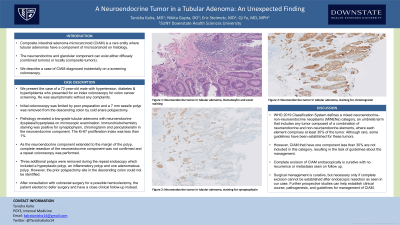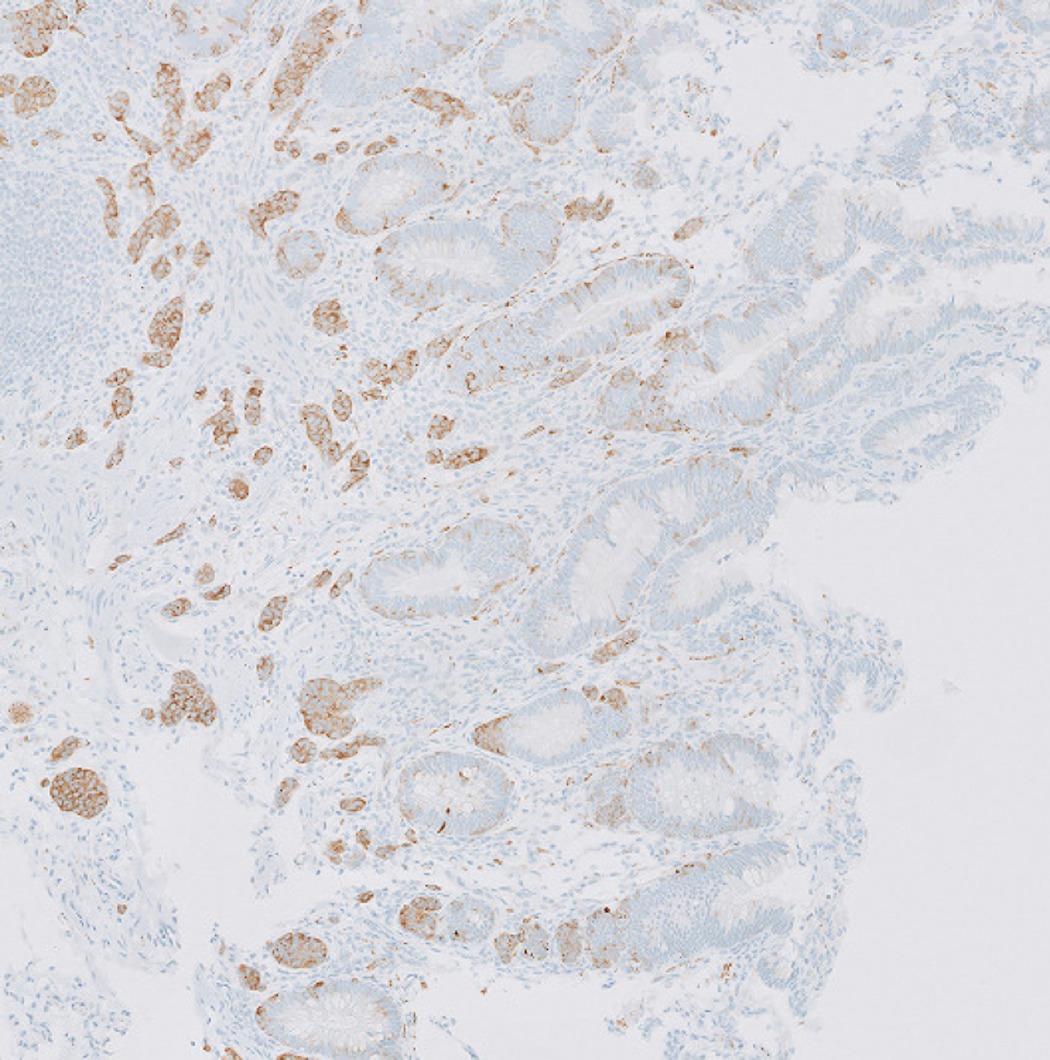Sunday Poster Session
Category: Colon
P0316 - A Neuroendocrine Tumor in a Tubular Adenoma: An Unexpected Finding
Sunday, October 22, 2023
3:30 PM - 7:00 PM PT
Location: Exhibit Hall

Has Audio

Tanisha Kalra, MD
SUNY Downstate Health Sciences University/NYCHHC Kings County Hospital
New York, NY
Presenting Author(s)
Tanisha Kalra, MD1, Nikita Gupta, DO1, Eric Steimetz, MD2, Qi Yu, MD, MPH3
1SUNY Downstate Health Sciences University/NYCHHC Kings County Hospital, New York, NY; 2SUNY Downstate Health Sciences University, Brooklyn, NY; 3SUNY Downstate Health Sciences University/NYCHHC Kings County Hospital, Brooklyn, NY
Introduction: Composite intestinal adenoma-microcarcinoid (CIAM) is a rare entity where tubular adenomas have a component of microcarcinoid on histology. The neuroendocrine and glandular component can exist either diffusely (combined tumors) or locally (composite tumors). We describe a case of CIAM diagnosed incidentally on a screening colonoscopy.
Case Description/Methods: We present the case of a 72-year-old male with hypertension, diabetes & hyperlipidemia who presented for an index colonoscopy for colon cancer screening. He was asymptomatic without any complaints. Initial colonoscopy was limited by poor preparation and a 7 mm sessile polyp was removed from the descending colon by cold snare polypectomy. Pathology revealed a low-grade tubular adenoma with neuroendocrine dysplasia/hyperplasia on microscopic examination. Immunohistochemistry staining was positive for synaptophysin, chromogranin and pancytokeratin in the neuroendocrine component. The Ki-67 proliferation index was less than 1%. As the neuroendocrine component extended to the margin of the polyp, complete resection of the neuroendocrine component was not confirmed and a repeat colonoscopy was performed. Three additional polyps were removed during the repeat endoscopy which included a hyperplastic polyp, an inflammatory polyp and one adenomatous polyp. However, the prior polypectomy site in the descending colon could not be identified. After consultation with colorectal surgery for a possible hemicolectomy, the patient elected to defer surgery and have a close clinical follow-up instead.
Discussion: The WHO 2019 Classification System defines a mixed neuroendocrine–non-neuroendocrine neoplasms (MiNENs) category, an umbrella term that includes any tumor composed of a combination of neuroendocrine and non-neuroendocrine elements, where each element comprises at least 30% of the tumor. Although rare, some guidelines have been established for these tumors. However, CIAM that have one component less than 30% are not included in this category, resulting in the lack of guidelines about the management. The clinical outcome is usually favorable. Complete excision of CIAM endoscopically is curative with no recurrence or metastasis seen on follow up in most other reported case series. Surgical management is curative as well, but is necessary only if complete excision cannot be established after endoscopic resection as seen in our case. Further prospective studies can help establish clinical course, pathogenesis, and guidelines for management of CIAM.

Disclosures:
Tanisha Kalra, MD1, Nikita Gupta, DO1, Eric Steimetz, MD2, Qi Yu, MD, MPH3. P0316 - A Neuroendocrine Tumor in a Tubular Adenoma: An Unexpected Finding, ACG 2023 Annual Scientific Meeting Abstracts. Vancouver, BC, Canada: American College of Gastroenterology.
1SUNY Downstate Health Sciences University/NYCHHC Kings County Hospital, New York, NY; 2SUNY Downstate Health Sciences University, Brooklyn, NY; 3SUNY Downstate Health Sciences University/NYCHHC Kings County Hospital, Brooklyn, NY
Introduction: Composite intestinal adenoma-microcarcinoid (CIAM) is a rare entity where tubular adenomas have a component of microcarcinoid on histology. The neuroendocrine and glandular component can exist either diffusely (combined tumors) or locally (composite tumors). We describe a case of CIAM diagnosed incidentally on a screening colonoscopy.
Case Description/Methods: We present the case of a 72-year-old male with hypertension, diabetes & hyperlipidemia who presented for an index colonoscopy for colon cancer screening. He was asymptomatic without any complaints. Initial colonoscopy was limited by poor preparation and a 7 mm sessile polyp was removed from the descending colon by cold snare polypectomy. Pathology revealed a low-grade tubular adenoma with neuroendocrine dysplasia/hyperplasia on microscopic examination. Immunohistochemistry staining was positive for synaptophysin, chromogranin and pancytokeratin in the neuroendocrine component. The Ki-67 proliferation index was less than 1%. As the neuroendocrine component extended to the margin of the polyp, complete resection of the neuroendocrine component was not confirmed and a repeat colonoscopy was performed. Three additional polyps were removed during the repeat endoscopy which included a hyperplastic polyp, an inflammatory polyp and one adenomatous polyp. However, the prior polypectomy site in the descending colon could not be identified. After consultation with colorectal surgery for a possible hemicolectomy, the patient elected to defer surgery and have a close clinical follow-up instead.
Discussion: The WHO 2019 Classification System defines a mixed neuroendocrine–non-neuroendocrine neoplasms (MiNENs) category, an umbrella term that includes any tumor composed of a combination of neuroendocrine and non-neuroendocrine elements, where each element comprises at least 30% of the tumor. Although rare, some guidelines have been established for these tumors. However, CIAM that have one component less than 30% are not included in this category, resulting in the lack of guidelines about the management. The clinical outcome is usually favorable. Complete excision of CIAM endoscopically is curative with no recurrence or metastasis seen on follow up in most other reported case series. Surgical management is curative as well, but is necessary only if complete excision cannot be established after endoscopic resection as seen in our case. Further prospective studies can help establish clinical course, pathogenesis, and guidelines for management of CIAM.

Figure: Immunohistochemistry staining for synaptophysin showing the neuroendocrine component within the tubular adenoma.
Disclosures:
Tanisha Kalra indicated no relevant financial relationships.
Nikita Gupta indicated no relevant financial relationships.
Eric Steimetz indicated no relevant financial relationships.
Qi Yu indicated no relevant financial relationships.
Tanisha Kalra, MD1, Nikita Gupta, DO1, Eric Steimetz, MD2, Qi Yu, MD, MPH3. P0316 - A Neuroendocrine Tumor in a Tubular Adenoma: An Unexpected Finding, ACG 2023 Annual Scientific Meeting Abstracts. Vancouver, BC, Canada: American College of Gastroenterology.
